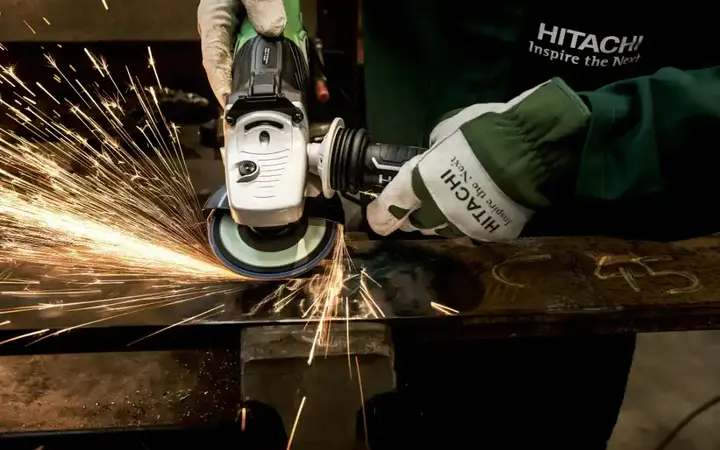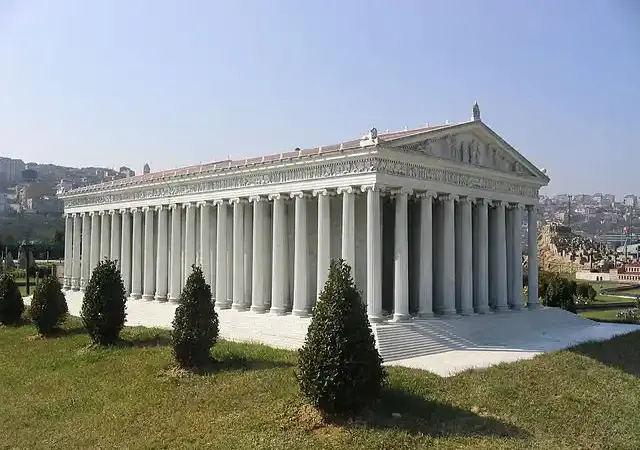Rare Roman ruins in Timgad Algeria
The ancient ruins of Timgad in Algeria are one of the most beautiful Roman archaeological sites in existence. Created on a perfect square grid, it is the same layout and design as the ancient Roman cities. No wonder when you know that the ruins in Timgad earned the nickname of the "African city of Bombay" because of its similarity to the ancient Roman city of Bombay. I love visiting old cities, so Timgad was definitely one of the highlights of my trip to Algeria.
Show key points
- Timgad, founded by Emperor Trajan in 100 AD as a Roman military colony, showcases a near-perfect grid layout characteristic of Roman urban planning.
- The ruins are exceptionally well-preserved due to their protection by UNESCO since 1982, offering visitors an authentic sense of ancient Roman life.
- Among Timgad's highlights are the public library—one of only two known Roman public libraries—and a vast theater capable of seating 3,500 people.
- ADVERTISEMENT
- Located far from the Mediterranean coast, Timgad was strategically built to control a key mountain passage to the Sahara Desert.
- The architectural marvels include Trajan’s Arch, the Grand Baths, and the Capitol, reflecting Timgad’s religious and civic significance.
- Timgad’s ruins reflect societal values of the time, with uniformly sized houses symbolizing equality among Roman citizens.
- Though remote and lacking nearby accommodations, Timgad makes for a worthwhile day trip from cities like Constantine, offering rich historical insights for a low entry fee.
The reason for Timgad's distinction
Timgad is one of the few cities with Roman ruins in Algeria, and was in the process called "Tamoqadi". I must admit that Timgad is more impressive than Tipaza, which is also famous for its antiquities, but what surprised me was that Timgad's antiquities are well preserved (they have been under UNESCO protection since 1982). Wandering through the ruins of ancient Timgad gives you a very authentic feeling, as your feet trample the street paved from the real Roman era under your feet, and you hear the water channel beneath it. Beautiful columns have been standing for almost 2,000 years, and there is even more to the streets, there is a public library, ancient houses and even toilets.
Recommend
Timgad Foundation
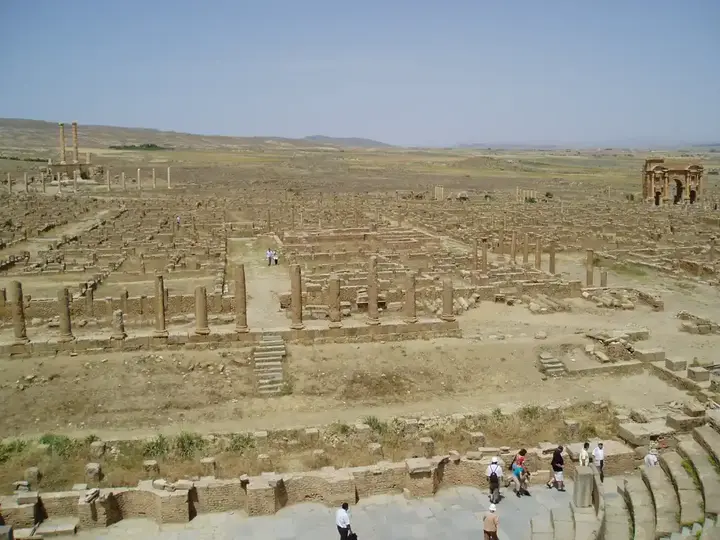
In 100 AD, Emperor Trajan built the settlement of Timgad, then known as Thamogas, probably as the base for the Augustan III Corps.
Timgad was a military colony and a catalyst for the African people to serve in the Roman army, as anyone who did so for 25 years would have a home at the base. An interesting point to note about the ruins of Timgad is that all the houses built there were similar in size, a sign of equality among the citizens of Rome. The original settlement was an ideal square, spanning an area of 355 square meters. Timgad continued to grow throughout the second century and reached its peak during the reign of Septimius Severus, from which most of the current buildings are dated. In the fifth century AD much of Timgad was damaged, and despite the brief Byzantine revival of the settlement under Justinian, it was abandoned by the eighth century AD.
The ancient Roman ruins of Timgad in the middle of nowhere?
When I got there, I was surprised to find that I was actually far from the sea, where most of my memories were of ancient Roman cities, on the Mediterranean coast. However, the ancient ruins of Timgad are far from any modern city, and about 170 kilometers from the coast. Why was Timgad built there? The function of this ancient city was to control one of the main passages through the Aures Mountains to the Sahara Desert. So, in Trajan's 100AD, the Roman emperor founded the military garrison city here.
What do you see in Timgad while wandering through the ancient ruins?
From the entrance, the path leads to the side of the gallery with pieces of ancient sculptures and engravings on the left. Soon you will see a red brick building, highlighting the stone ruins of Timgad. The Grand Baths of the North, a huge public place with about 40 rooms. The bathrooms were identical, with the same toilets and warm and heated rooms on both sides of the complex. The baths were originally outside the city gates.When walking down the street, you will finally enter the city of Timgad. Ruins of houses everywhere and beautiful columns on the sides of the street. What a beauty!
Timgad Roman Public Library
The most interesting building on this street is the public library for me the ancient library was very special because it is one of the only two public libraries known in Roman times, the other is located in Ephesus (Turkey). If you enter the library you can see the storage outlets of "books" (actually manuscript pages or parchment rolls).
After leaving the library and wandering a little, you will reach the city center, where the main street "Alcardo Maximus" meets between north and south with "Decommanus maximus", the main east-west artery of the city. The city center was a forum, a large open space, surrounded by Corinthian limestone columns, statues, a temple and municipal offices.
Trajan's Arch (Capitol)... Timgad Pearl
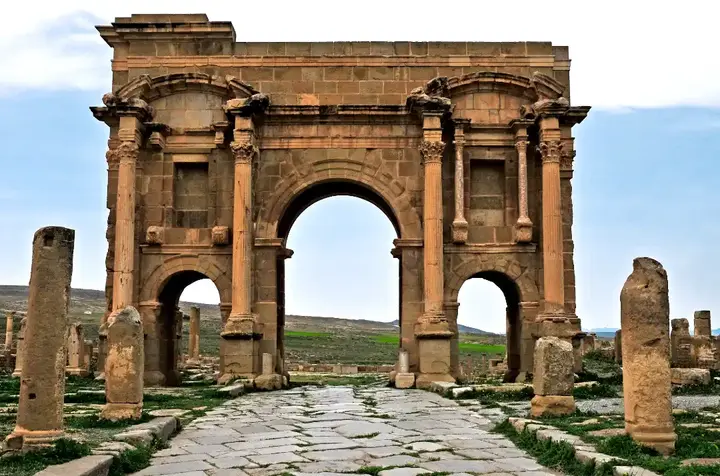
If you continue to turn right, you will reach the most impressive remaining buildings in the ancient ruins of Trajan's Arch in Timgad The gate was very elegant with columns and statues. The central high passage was for carriages, and the arches on the sides for pedestrians.Going to the left you will pass by the market of Certius which is one of the ruins that impressed me most in Timgad. The Capitol with huge columns still stands and some collapse. The Capitol was dedicated to the gods Jupiter, Juno and Minerva. This was the most sacred place of pagan worship.
Timgad Roman Theatre

Continue walking towards the theater. Imagine it can host 3,500 people! From there you can admire the view in the entire ancient city of Timgad. Most of what we see today is reconstruction by French archaeologists. The nearby castle was built by soldiers after the original theater was destroyed in 539 AD. The Byzantines chose to build the fortress outside the original settlement. You can still see the remaining wide walls.
Timgad Today
Among other attractions, including the excellent example of Roman city planning, visitors can see the remains of Trajan's stunning second-century arch, a theater with a capacity of 3,500 spectators, a forum and a series of 14 bath complexes. There is even a library and the remains of temples and churches, the latter showing the later prominent Christian presence in Timgad.
Arriving in Timgad
Timgad is about 5 hours from Algiers, but still makes a nice day trip when connecting Algiers to Constantine (which takes two hours). To get there, you have to go by car. From Tunis take the A1 motorway to Constantine and then N79 to Timgad.
Timgad as if you are there
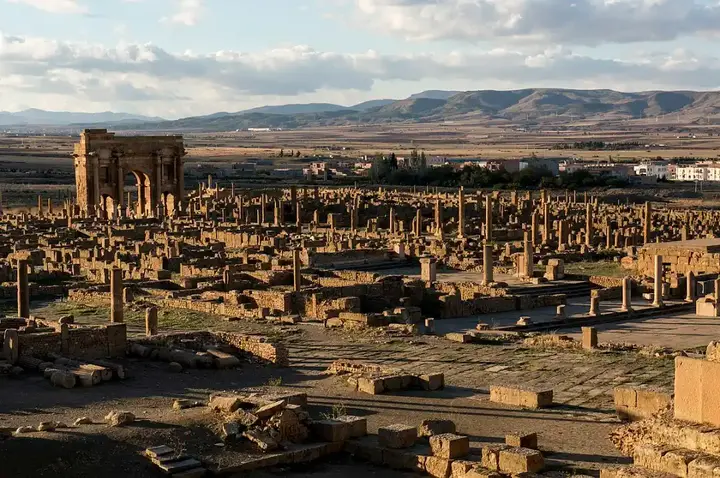
The entire open space of ancient ruins does not contain trees, which is very windy. Remember to take some warm clothes, as they may be a little cooler than in other parts of the country.
A ticket to visit Timgad "African Bombay" costs about 200 Algerian dinars, less than one euro. Outside the entrance, there are a few souvenir stalls, where you can get some local and Chinese things.
I didn't see any hotel nearby. The closest place you can stay I think is in Constantine where you will get better choices of accommodation. Visiting Timgad is a perfect idea for a day trip from Constantine.
Have you visited the ancient Roman ruins in Timgad?
![]()
The four highest capitals in the world are located in Latin America, what are they?
Many Latin American capitals sit high in the mountains for reasons like cooler climates, better defense from pirates, and historical ties to indigenous sites. Cities like La Paz, Quito, and Bogotá remain notable for their altitude, beauty, and strategic importance since colonial times. more- ADVERTISEMENT
![]()
Extremely large telescopes: the next big thing in astronomy
Giant telescopes like the upcoming ELT and GMT are set to unlock deep cosmic secrets—from the first galaxies to possible signs of life on exoplanets. These powerful tools promise stunning discoveries and a clearer understanding of our universe’s origins and mysteries. more- ADVERTISEMENT
![]()
Does pregnancy accelerate "biological aging"?
A study in the Philippines found that pregnancy may speed up biological aging in women, with each pregnancy linked to about 4 to 4.5 months of aging. This effect wasn't seen in men, and varied depending on context. Researchers hope these insights might guide future anti-aging treatments. more- ADVERTISEMENT
![]()
Historic Nizwa Fort... The splendor of construction since the seventeenth century AD
Nizwa, once Oman's capital, is famed for its mighty fort, rich history, and stunning mountain views. Its iconic circular tower, ancient defenses, and vibrant museum make it a top spot for visitors seeking a real taste of Omani heritage and breathtaking panoramas. more- ADVERTISEMENT
![]()
Best Graphic YouTube Design Learning Channels in Arabic
Noor Design Channel stands out by teaching design basics like color theory in a hands-on way, helping many Arabs become skilled designers. It also guides learners on turning design skills into freelance work, making it a top pick for Arabic-speaking beginners. more- ADVERTISEMENT
![]()
3 skills in demand in the labor market to get a job
3 Skills required in the labor market to get a job more- ADVERTISEMENT
![]()
The Enigmatic Universe: 8 Astonishing Facts about Space and Time
Black holes might be gateways to parallel worlds, and time itself could possibly be reversed—just theories for now, but thrilling ones that stir curiosity. Dark energy and matter, though unseen, dominate our universe. And yes, UFOs still spark debate. The cosmos remains full of mysteries waiting to unfold. more- ADVERTISEMENT
![]()
Sand and fog skies: a harsh introduction to Mauritania
Nouadhibou may appear harsh and chaotic, yet its dusty markets and joyful children reveal a community full of resilience and warmth. Despite poverty and challenges, the city radiates human spirit and hope, offering visitors an unforgettable glimpse into a life built on adaptation and cooperation. more- ADVERTISEMENT
![]()
The Search for the Lost Temple of Artemis: A Journey Through Time and Secrets
Hunting for the Lost Temple of Artemis-A Journey Through Time and Mystery more- ADVERTISEMENT
![]()
Topkapi Palace ... The largest palaces of Istanbul in Turkey
Topkapi Palace, once home to Ottoman sultans, dazzles with over 12,000 porcelain pieces and secretive chambers. Known as the "Palace of Happiness," it’s now a UNESCO World Heritage Site and ranks among Europe's most visited museums, drawing millions into its rich blend of history, culture, and architectural beauty. more- ADVERTISEMENT

















